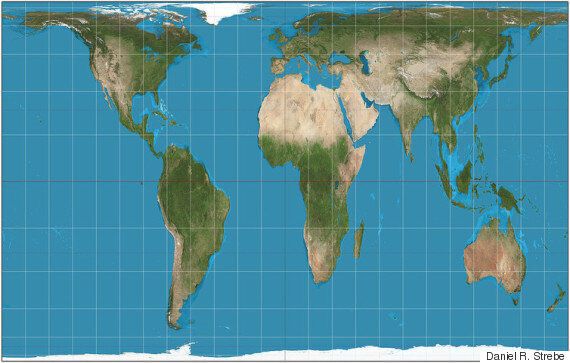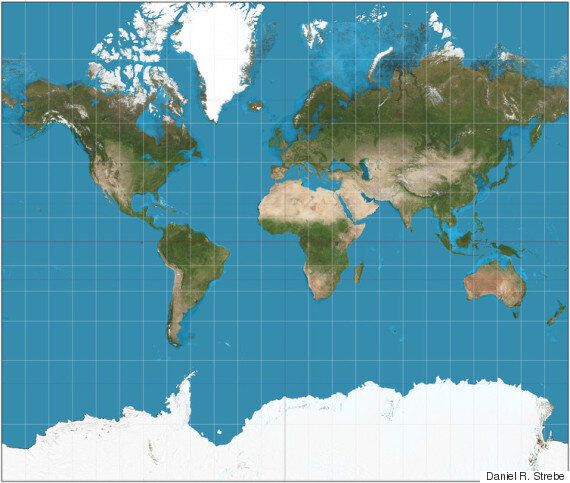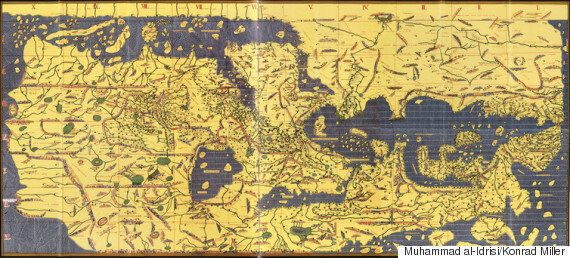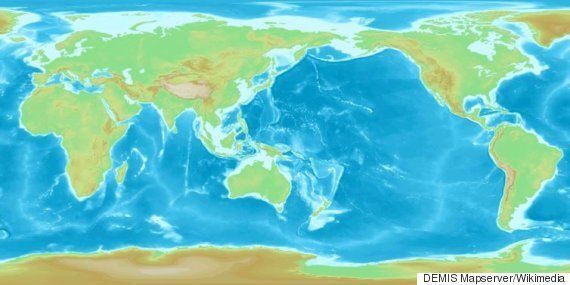Boston public schools recently announced that they will shift to using world maps based on the Peters projection, reportedly the first time a US public school district has done so. Why? Because the Peters projection accurately shows different countries' relative sizes. Although it distorts countries' shapes, this way of drawing a world map avoids exaggerating the size of developed nations in Europe and North America and reducing the size of less developed countries in Asia, Africa and South America.

Peters projection.
This is what happens with the more commonly used Mercator projection, which exaggerates the size of the Earth around the poles and shrinks it around the equator. So the developed "global North" appears bigger than reality, and equatorial regions, which tend to be less developed, appear smaller. It's especially problematic given that the first world maps based on the Mercator projection were produced by European colonialists.
Why does this problem occur? Simply put, the world is round and a map is flat. Imagine drawing a world map on an orange, peeling the skin to leave a single piece and then flattening it. It would, of course, rip. But imagine you could stretch it. As you did so, the map drawn on its surface would distort.

Mercator projection.
The distortions this introduces are massive. And different projections distort maps in different ways. The Mercator projection depicts Greenland as larger than Africa. But, in reality, Africa is 14 times the size of Greenland. It alters the way you see the size - and, some people argue, the way you see the importance - of different parts of the world. So this isn't just a cartographer's dilemma - it's a political problem.
The Renaissance cartographer Gerardus Mercator did this to preserve the shapes of countries, so the map could be used to accurately calculate compass bearings. Accurate compass bearings are very important if you are a 16th century seafarer. But if you want a better idea of the relative size of the world's landmasses, you need a map that distorts shape but preserves area, like the Peters projection does.

Mercator's original 1569 map.
Gerardus Mercator
The difference between the Peters and Mercator projections shows how significant changing the way a map is drawn can be. Here are four other map styles that each come with their own political implications.
South-up

South-up Peters projection.
Daniel R. Strebe, CC BY-SA
North is up, right? Only by convention. There's no scientific reason why north is any more up than south. Equally, we could do east-up, west-up or any other compass bearing. Purposefully reversing the typical way world maps are drawn has a similar political effect to using the Peters projection, putting more developing countries in the generally poorer southern hemisphere at the top of the map and so giving them greater significance.
But some of the first known world maps put south at the top as a matter of course. For example, in 1154 Arab geographer Muhammad al-Idrisi drew a south-up map of Europe, Asia and northern Africa for his book the Tabula Rogeriana. The Arabian Peninsula can be seen in the centre of the map but, of course, pointing upwards rather than the more familiar downwards.

1927 recreation of the Tabula Rogeriana.
Pacific-centred
Another convention of world maps is that they are centred on the prime meridian, or zero degrees longitude (east-west). But this is scientifically arbitrary, deriving from the location of the Royal Observatory in Greenwich, London. The result is that Europe (although also Africa) is in the centre of the conventional world map - a rather colonial perspective.

Pacific-centred map.
The familiar meridian-centred map conveniently places the map edges down the middle of the Pacific Ocean so no continent is chopped in two. But maps centred on the Pacific Ocean also work well because the edges of the map conveniently run down the middle of the Atlantic. This places east Asia in a more prominent position and pushes Europe to the edge. Much of Oceania and Asia uses Pacific-centred maps. (American-centred maps are also in use, but these have the unfortunate consequence of partitioning Asia to either side of the map.)
Our meridian-centred view of the world shapes how we refer to world regions. "Far East", for example, implies far from Greenwich, London. Seeing Europe on the left of a map and the Americas on the right can seem counter-intuitive, but it is just as correct as any other arbitrary chop point. The world is, after all, round.
Azimuthal polar projection
Azimuthal equidistant projection.
All the projections we've discussed so far tend to put one continent in the middle of the map, giving it greater prominence over the others. An alternative is to place the North Pole in the centre. It is strangely disorienting to gaze on the world from a polar perspective. The lower hemisphere should be hidden from view by the curve of the Earth because you can only see half a sphere at a time.
But on the azimuthal polar projection from the north, the southern hemisphere has been pulled into view on the page, with the consequence that Antarctica centrifuges into a doughnut around the edge of the circular map. This highlights the disadvantage of the projection as it distorts both the area and shape of landmasses, but distances from the North Pole are accurate in all directions, with those further from the centre becoming more enlarged on their east-west axis.
UN logo.
United Nations
This "azimuthal" polar projection is depicted on the United Nations flag. North America was prominent on the initial 1945 UN flag (which had the longitude line 90 degrees west pointing upwards). The following year, the map on the flag was reoriented to be more neutral by having the international date line (180 degrees east, lying in the middle of the Pacific Ocean) pointing upwards. The map stops at latitude 60 degrees south, meaning Antarctica does not appear.
Cartograms

Voter turnout cartogram.
Worldmapper.org / Sasi Group (University of Sheffield) and Mark Newman (University of Michigan)., CC BY
Another way of representing the world is to display countries' sizes in proportion to key indicators of interest to geographers today, such as population, environment and development. Predictably, the world map of GDP is dominated by North America and Europe, while Africa almost disappears. The population cartogram gives greater prominence to India and China, and makes Indonesia far bigger than neighbouring Australia. But perhaps more surprising is the map of voter turnout, where emerging economies are bigger - and North America smaller - than many people might suppose.
Now more than ever, we need to be able to see the world from different perspectives. Any one perspective is not any more correct than another - just different.
Donald Houston, Head of Geography, University of Portsmouth
This article was originally published on The Conversation. Read the original article.
